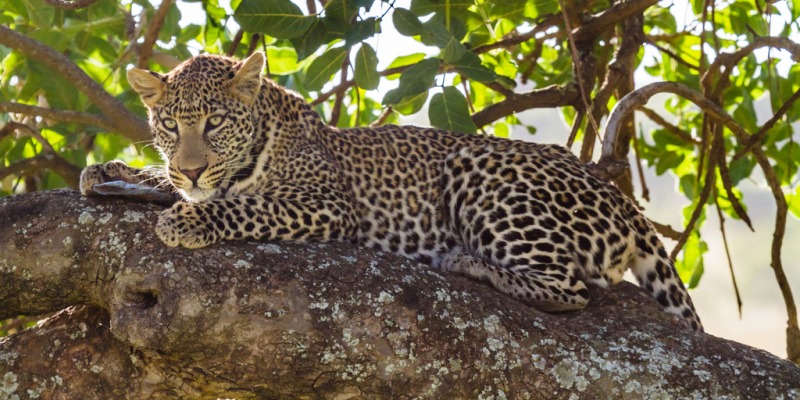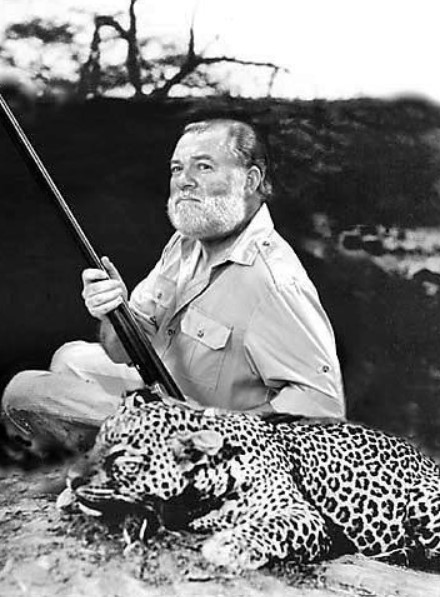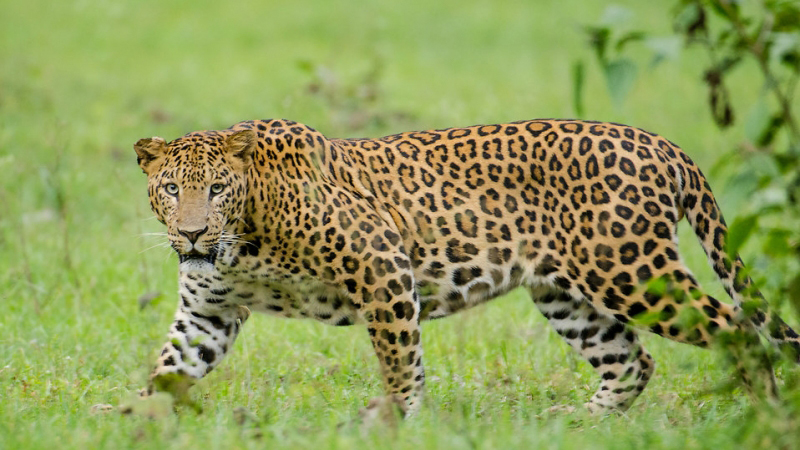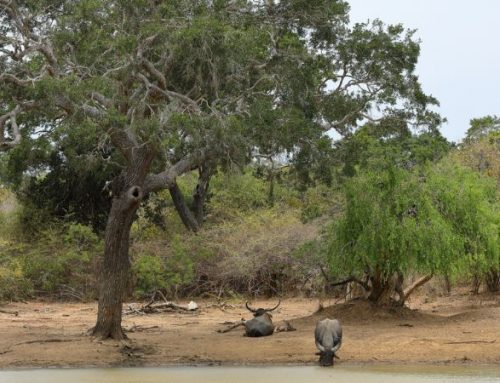Africa is undoubtedly the continent that best of all knows how to give you unique emotions and indelible memories such as the leopard hunting.
Every hunter, after a safari in Africa, brings with him a great desire to return. The adrenaline for the Big Five hunting is an experience to be lived in one breath and, in particular, the leopard hunt is an overwhelming and exciting hunt.
Huntable in almost the entire African continent, the leopard is an animal with a shy and solitary nature, which leads it to take refuge in the trees and hunt mainly at night. It is a very skilled climber, loves to rest and hide on the branches, on which it manages to blend very well, thanks to its spotted coat.
Due to its temperament, it is a difficult animal to be identified and that is why leopard hunting becomes an exciting, suggestive and adrenaline-filled hunting, able to make you experience the true emotions of the African Safari par excellence!
Are you ready to discover the secrets of leopard hunting?
How leopard hunting takes place
First a suitable tree is chosen, with a long horizontal branch at a certain height, then the bait is placed and after checking for days if the cat has liked the it, a blind is built at about 50 meters and waits.
Locked in the blind already in the late afternoon, you look at the bait hanging from the tree and hidden by tufts of leaves to hide it from the hunger of the vultures with a very sharp view.
You check the safety of the rifle, look and look in the optics, already aimed at the branch on which “he” it should crouch before harpooning the piece of meat.
The darkness begins to fall, the daytime noises of the bush fade and the nocturnal concert begins: a couple of nocturnal birds, a distant hyena and a serenade of jackals, to invoke the moon.
Then, imperceptibly, a light, cadenced, almost metallic noise: they are his claws on the trunk, he is hoisting himself on the main branch to grab the piece of zebra or impala “set” for him.
The silhouette now stands out against the sky but it is too dark to shoot. The PH touches the hunter’s leg. It is the agreed signal. The heart begins to beat faster, the forehead is beaded with sweat: the moment has come.
The hunter hunches over the rifle and targets the silhouette of the feline while the PH turns on a progressive green light that does not disturb the animal and that allows the customer to place the optics cross on his shoulder.
The shot breaks the silence of the night, then all is silent and the figure on the branch has disappeared. They wait a few minutes… interminable. Then you go out with your weapon pointed and powerful lights that break the darkness of the African night.
Two drops of blood a few meters from the trunk and … the leopard lies lifeless a little further on.
This is the classic leopard hunt, the most exciting, whose techniques the P.H. have been handed down for generations.
Other techniques for leopard hunting typologies
Another way to hunt the feline is hunting with hounds which, although exciting, is less suggestive: the dogs find the leopard, force it to climb a tree and the hunter approaches twenty meters and shoots.

In keeping with ancient traditions, bait hunting has a different, very African flavor, as it was already practiced at the beginning of the century.
Recommended weapons
Rifles starting from a good 300 and up are ideal with 180 grain bullets.

Chapuis rols straight pull rifle is ideal for safaries
Straight-pull rifles are often favored for African safaris due to several key advantages that make them well-suited for hunting in diverse and challenging environments:
Speed and Efficiency: Straight-pull rifles allow for faster follow-up shots compared to traditional bolt-action rifles. With a simple back-and-forth motion, the shooter can quickly cycle the action without needing to lift or rotate the bolt, enabling faster shooting in situations where a rapid second shot may be necessary.

Beretta BRX 1 straight pull is the perfect weapon for leopard hunting
Reliability: Straight-pull rifles are known for their reliability. They have fewer moving parts than traditional bolt-action rifles, reducing the chances of mechanical issues or jamming, which can be crucial in unpredictable and demanding safari environments.
Ease of Use: The straight-pull action tends to be more intuitive and easier to manipulate for some shooters compared to bolt-action rifles. This can be especially beneficial in high-pressure situations or when quick reactions are required.
Adaptability and Maneuverability: Straight-pull rifles often have shorter bolt throws, which can make them more compact and easier to handle in confined spaces or dense bush environments, commonly encountered in African safaris. This maneuverability can be advantageous when tracking or hunting in challenging terrain.
Versatility: They can accommodate different cartridge lengths, allowing for versatility in ammunition selection. This can be beneficial when facing a variety of game species with different size and toughness.
However, it’s important to note that the choice of a rifle for an African safari depends on personal preference, comfort, and the specific needs of the hunter. Some hunters might prefer the familiarity of a bolt-action rifle, while others might find the advantages of a straight-pull action more appealing for their style of hunting.
Ultimately, the suitability of a rifle for an African safari depends on factors such as the hunter’s experience, the type of game being pursued, the environment, and individual preferences in handling and operation.
For driven hunts or to search a wounded animal, the good old 12-gauge semi-automatic loaded with buckshot is a guarantee.

The Benelli M2 slug semi automatic cal. 12 is best suited for hunting in the thick of the bush
Among the Big Five animals, the leopard is undoubtedly one of the most difficult felines to find, due to its nocturnal habits and its climbing ability.
The famous writer and adventurer Ernest Hemingway had sensed that instinct. That same instinct that made him identify with this wonderful feline: to always act to overcome one’s limits with the consequence of visiting and experiencing places with brazen intensity.

Ernest Hamingway with his leopard just hunted in an african safari
The Leopard
The African leopard (Panthera pardus pardus) is a majestic and adaptable big cat species found across various habitats in sub-Saharan Africa. It’s one of the most widespread and versatile of all big cats, inhabiting a variety of environments from savannas and grasslands to forests, mountains, and even semi-desert regions.
Here are some key features and characteristics of the African leopard:
- Physical Characteristics: Leopards are easily recognizable due to their distinctive spotted coat. Their fur ranges from pale yellow to golden or tawny, covered with dark rosettes that provide excellent camouflage in their surroundings. Some leopards, particularly those found in dense forests, have darker coats to aid concealment.
- Size and Build: They are medium-sized big cats, with males typically larger and heavier than females. On average, they weigh between 70 to 160 pounds (32 to 73 kilograms). They have a sleek, muscular build, and their elongated bodies, adapted for agility, allow them to climb trees and haul their prey up into branches.
- Habitat and Behavior: African leopards are solitary and elusive animals, preferring to roam and hunt alone. They are primarily nocturnal, although they can also be active during dawn and dusk. Leopards are incredibly stealthy and are known for their ability to stalk and ambush their prey.
- Diet: These carnivores are opportunistic hunters and have a diverse diet. They prey on a wide range of animals, including antelopes, monkeys, rodents, birds, and occasionally larger animals like young ungulates. Leopards are skilled climbers and often hoist their kills into trees to protect them from scavengers like hyenas or lions.
- Cultural Significance: Leopards hold cultural significance in various African cultures and folklore, often symbolizing strength, stealth, and power. They are revered for their beauty and adaptability, earning a place in stories and traditions across the continent.
African leopards play a vital role in maintaining the ecological balance of their habitats. Efforts to conserve these elusive and magnificent creatures involve protecting their territories, mitigating human-wildlife conflicts, and ensuring sustainable practices to safeguard their populations for future generations.
If your dream is to experience an unforgettable safari in Africa, don’t wait any longer.
FAQ – Leopard Hunting in Africa with Montefeltro
1. Why is leopard hunting considered uniquely thrilling?
Leopard hunting offers a rare blend of intensity, elegance, and psychological challenge. These big cats are apex predators that rely on stealth rather than brute strength. They hunt alone, mostly at night, and are extraordinarily elusive. For the hunter, this means that every moment leading to the encounter is charged with suspense. There is no fanfare, no early warning. When the leopard finally steps into view, it often feels like a dream, quick, surreal, electric. Unlike other hunts where tracking is physical and visible, leopard hunting plays out in the shadowy borders of instinct and patience. It’s this refined dance with one of nature’s most intelligent felines that makes the experience unforgettable.
2. Where can one hunt leopards with Montefeltro?
Montefeltro organizes exclusive leopard hunts in some of Africa’s most iconic locations, particularly in Tanzania and Zimbabwe, two countries renowned for their vast, untouched wilderness. In Tanzania, hunting concessions stretch across legendary ecosystems like the Selous Game Reserve and the Masailand areas, offering both beauty and biodiversity. Zimbabwe, especially in regions like the Zambezi Valley or Matetsi, provides rich, game-filled bushveld where the leopard thrives. These locations aren’t just hunting grounds—they are immersive environments where the wild remains truly wild.
3. What methods are used to hunt leopard ethically and effectively?
The most widely practiced and effective method is baiting and blind hunting. A bait, typically a portion of meat from plains game, is carefully selected and hung in a suitable tree, often where fresh leopard tracks have been observed. The site is monitored for signs of activity, including claw marks, droppings, or night-time visits confirmed via trail cameras. Once the leopard starts feeding, a hunting blind is set up, strategically placed downwind, camouflaged, and positioned for a clean shot at 40–50 meters. Hunts are typically conducted during the late afternoon and into the evening, when leopards become active. The atmosphere in the blind is thick with tension, anticipation, and silence.
4. What is the experience like when the leopard arrives?
Everything slows down. Time stretches as the light fades. Then, without warning, there’s a shift, a sound, a movement in the canopy, or the glint of golden eyes. The leopard often arrives silently, almost like a spirit, blending into the dimming landscape. For the hunter, this moment is electrifying. The heart pounds. Breath is held. Every muscle tightens in concentration. The PH whispers instructions. The window for action is small and sacred. If the hunter is composed, focused, and respectful of the moment, a clean, ethical shot is taken, the culmination of days of effort compressed into a few eternal seconds.
5. Is dog-assisted leopard hunting also used?
Yes, although less common, dog-assisted leopard hunting is practiced in select areas. Specially trained hounds are used to track and tree the leopard. This method is more dynamic and physical, involving long walks, listening to hound signals, and rapid movement through brush and terrain. Once the leopard is treed, the hunter approaches carefully to assess and act. While this method increases chances of a visual, it requires excellent fitness, calm under pressure, and tight coordination with the dog handler and PH.
6. What makes leopard hunting such a rare privilege?
Several factors contribute to its rarity. Firstly, leopards are secretive and mostly nocturnal, they leave minimal signs and often double back to evade detection. Secondly, hunting quotas for leopards are strictly limited and monitored, meaning only a few select tags are available each season. Third, the physical environment—rugged, remote, and challenging—requires both logistical preparation and emotional stamina. Successfully hunting a leopard is a high achievement, often reserved for the most experienced and patient sportsmen.
7. How do Professional Hunters (PHs) prepare for a leopard hunt?
PHs begin by scouting areas known for leopard activity, using their deep knowledge of animal behavior and territorial patterns. They identify fresh tracks, locate possible bait trees, and monitor camera traps to confirm movement. They consider moon phases (leopards prefer darker nights), wind direction, and even local water sources. Once the bait is active, they construct blinds with extreme attention to detail, factoring in concealment, angle of approach, and shot trajectory. The PH also guides the hunter through safety protocols, animal identification, and shooting ethics, ensuring that the hunt meets legal and moral standards.
8. What equipment should a hunter bring?
For leopard hunting, Montefeltro recommends:
- A reliable bolt-action rifle, typically in the .300 to .375 caliber range
- High-quality optics, including a variable scope and night-vision or low-light binoculars
- Comfortable clothing in neutral tones (not camouflage, due to legal restrictions in some areas)
- Mosquito repellents, headlamp, gloves, and a wind checker
- A tripod or shooting stick for stable shots from the blind
- Sturdy boots, like Courtneys,and a small backpack with essentials (snacks, water, notebook, etc.)
Montefeltro also assists clients in selecting or renting local-approved gear and helps with firearm import permits.
9. Is leopard hunting sustainable and regulated?
Yes, and this is critical. Leopard hunting is tightly regulated by African wildlife authorities and CITES (Convention on International Trade in Endangered Species). Quotas are based on scientific data and monitored population studies. Montefeltro works exclusively with certified outfitters who adhere to sustainable hunting models, ensuring that each harvest contributes to the conservation effort by funding anti-poaching operations and supporting local communities.
10. Why choose Montefeltro for a leopard safari?
Because with Montefeltro, you are not just joining a hunt, you are entering a heritage of ethical hunting, fine logistics, and authentic African connection. Our PHs are not just guides; they are guardians of the bush, storytellers, and protectors of ancient traditions. From visa support to airport pickups, from first bait to final campfire, every detail is curated to offer you the most seamless and emotionally resonant hunting experience. This isn’t just a journey into Africa, it’s a step into the heart of what it means to be human, in pursuit of something greater than the self.

Montefeltro Staff, Luca Bogarelli
“Luca Bogarelli loves hunting and nature, experiencing both in a comprehensive manner. Adding to this, his passion for travel has led him over the years to explore places, people, and unique wildlife around the world.
A self-described ‘traveler with a rifle’, Luca has gathered hunting experiences across nearly the entire African continent, as well as in Asia, America, and Europe, in all the countries of hunting interest.”





